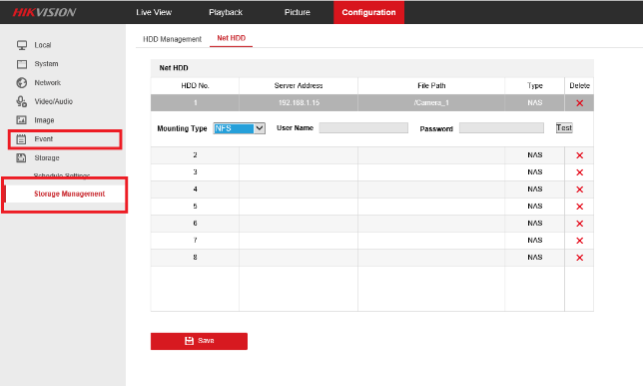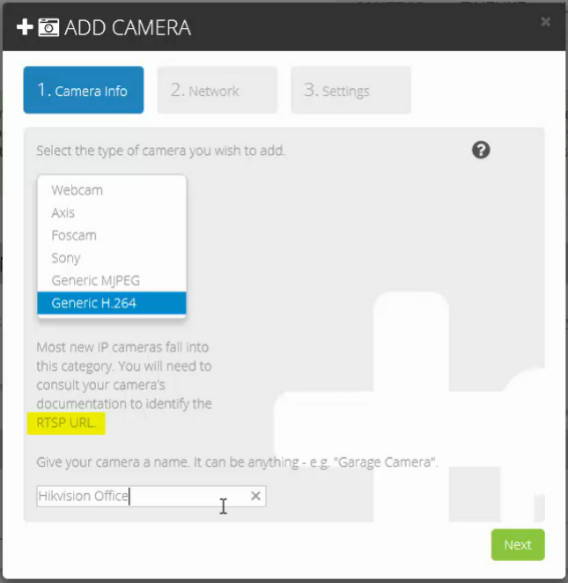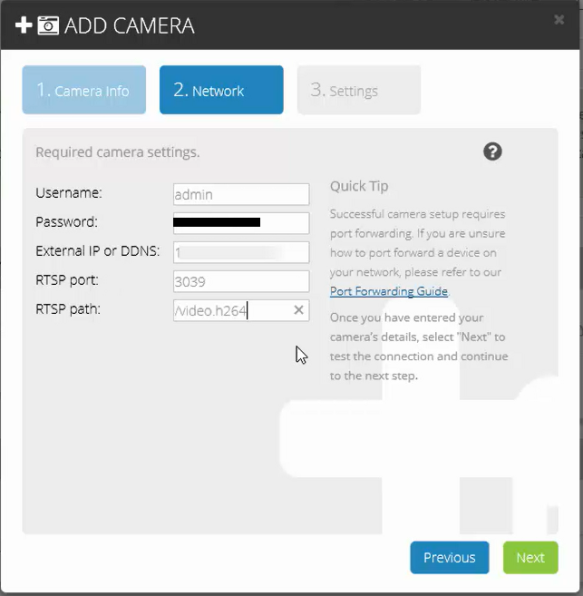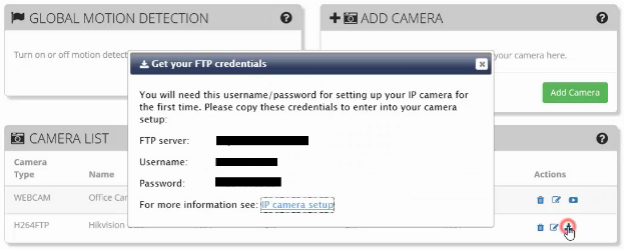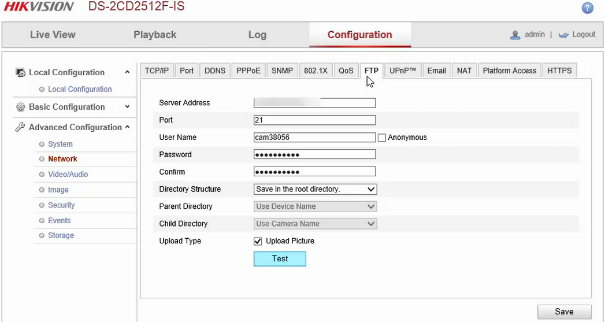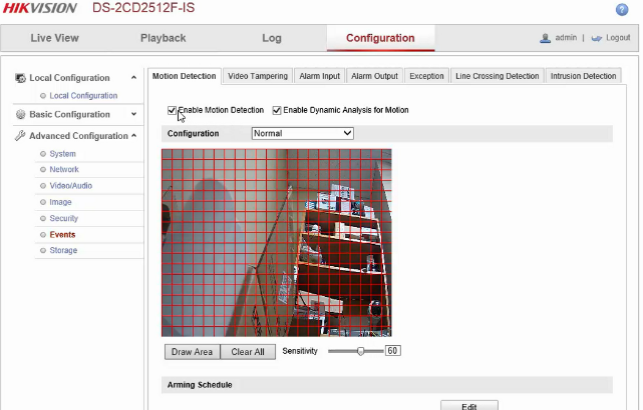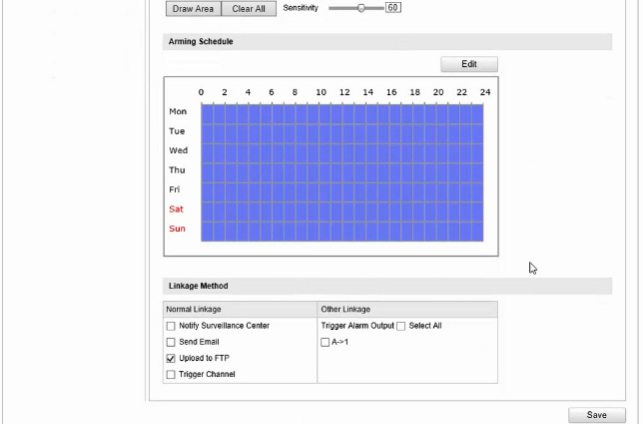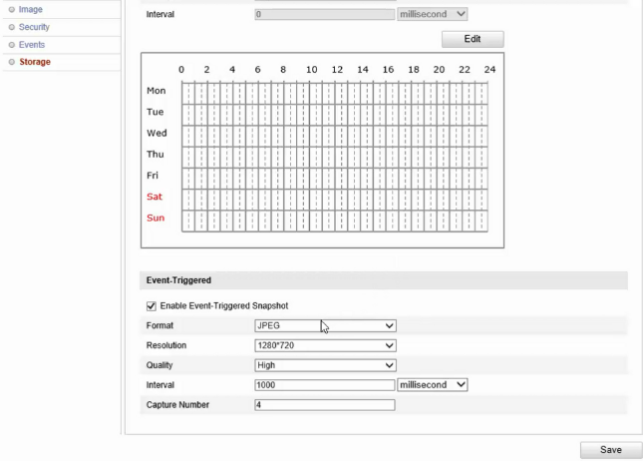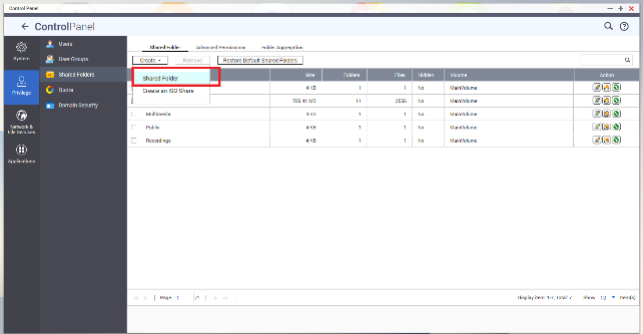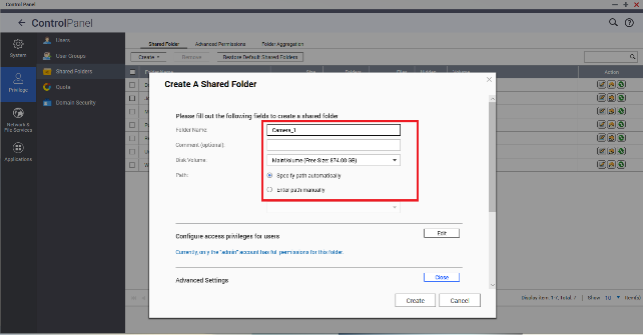How To Setup A Hikvision Camera With Camcloud, “Camcloud really fit the bill for us on many levels. The ease of deployment and speed to install translated into getting more customers up and running faster, with a modern solution”
Let’s show you how to setup a Hikvision Camera with Camcloud.
Step #1. Setup the Camera Wizard
First login to camcloud.com and go to the “Cameras” page. Then click on “Add Camera” to start the Camera Wizard. Since we’re dealing with Hikvision cameras, select “Generic H.264”. At this point, what you wanna do is make sure you know your camera’s RTSP URL.
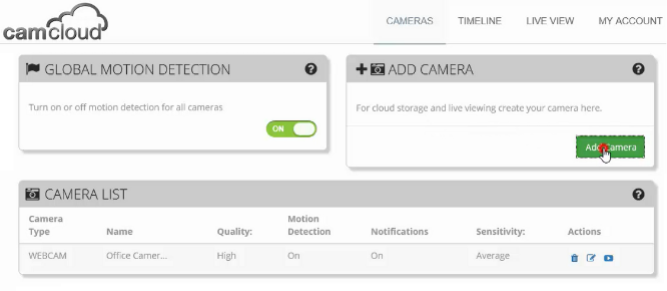
Now click on “Next” and fill up your info in the Network Setup. Make sure you use your camera’s password for the Network Setup, not the Camcloud password.
The RTSP port allows us to pull video from the camera. For the RTSP path (also known as the RTSP URL), punch in “/video.h264”. All I did to figure this out was to take a look at the documentation from Hikvision, and this is what the RTSP URL looked like.
If you’re not sure what yours is, just contact support@camcloud.com and we’ll help you figure it out.
Once you’re done, click on “Next”, and if it goes through it means you were successful at pinging the camera which means our Network Setup is complete.
How To Setup A Hikvision Camera With Camcloud
Side note: When we we first pop-up the dialogue to enter your FTP Credentials, we say ftp.camcloud.com is what you should use, but that doesn’t work for Hikvision Cameras. Instead, you should enter an IP, so ftp.camcloud.com doesn’t work on some models of Hikvision. You’ll have to use an FTP IP, which you can get by contacting support@camcloud.com.
Before you head over to the interface, make sure you’ve taken note of your FTP Credentials. You can find them on the cameras page here:
Step #2: Hikvision FTP Setup
Now go to the Hikvision Camera Interface and click on the “Configuration” tab, then under “Advanced Configuration” click on “Network”. Now click on the FTP tab.
This is where your FTP credentials are required. Keep in mind that the interface as of now doesn’t allow you to copy and paste the passwords in, so you’ll have to manually enter them both times.
Make sure the “Upload Picture” checkbox at the bottom is checked. Click on “test”, if it’s successful it means that you’ve configured with FTP correctly.
Step #3: Hikvision Interface Event and Storage Configuration
Once again under “Advanced Configuration”, click on “Events”. Make sure your Motion Detection is enabled and that you have a Motion Detection Area selected.
Scroll down, and under Linkage Method make sure “Upload to FTP” is checked.
The Last Step is to jump over to “Storage”, and click on the Snapshot tab. Scroll down and check on the “Enable Event-Triggered Snapshot” checkbox.
Now you’re ready to use cloud storage with Camcloud and your Hikvision camera. Now when there’s motion in front of the camera, you’ll be able to see what kind of motion activity was captured by the device.
Let us know your thoughts in the comments below.
Got questions? Contact us at support@camcloud.com.
How to Setup Network Attached Storage (NAS) for your Hikvision IP Camera
Setting up local video storage for your IP camera is a very common requirement, even if you are using cloud storage as the primary storage for your IP camera, many customers will still want to have redundant, local storage in case there is an Internet outage. The good news is this can easily be accomplished with almost any medium-range and up IP camera, and even some cloud video surveillance platforms allow local storage options to be easily configured and retrieved from the cloud apps.
This post will walk you through the steps for setting up Network Attached Storage (NAS) for your Hikvision camera, including a few “gotchas” we’ve learned along the way. (This post will focus on NAS setup, we will create a separate article for SD card setup.)
Important: The Gotchas you Need to Know
The first step is to prep your NAS so it is ready to accept video saved from a Hikvision IP camera. (Our screenshots are from a QNAP device but these steps are generally true for any device.) Before beginning there are a few upfront “gotchas” you need to know.
Are you enjoying our tutorial on this topic? We hope so! If you want to learn how to setup cloud video surveillance with Hikvision click here.
Setup Steps
Step 1: Basic NAS Setup. Begin by, (i) ensuring your NAS basic setup is complete according to its user manual (general setup, firmware updates, etc), (ii) you have your login credentials handy, (iii) the NAS is connected to your local network (including identifying its internal IP address), and (iv) you can reach the NAS UI from your web browser.
Step 2: Basic Hikvision Setup. Ensure your Hikvision IP camera is connected to the same network as your NAS.
Step 3: Create NAS Partition. Follow your NAS instructions for creating a partition — if using a new or separate hard disk drive (HDD), create a partition on that particular drive. In the case of QNAP, this is located in the Storage Manager settings but you’ll need to follow your NAS detailed guides for this step.
Step 4: Create Share Folders. You will need to create a share folder for each camera that will be using the NAS. Name each share folder a name that identifies with the camera being used, for example: Camera_1, Camera_2, Camera_3… etc. (It’s recommended that you don’t use any spaces in your folder names.)
Figure 1: Shared Folder Menu on QNAP
Figure 2: Shared Folder Options on QNAP
Step 5: Hikvision Storage Setup. Now you’re ready to configure your Hikvision camera storage options. First you’ll need to make the camera aware of the new storage location. This can be done under the following menu: Storage -> Storage Management -> Net HDD. Screenshot below shows where this is done. Here you click on any slot and fill in the server address (internal IP of the NAS) and the file path (share folder you created in step #4). Also enter the username and password of the NAS. Leave the mounting type as NFS if it’s a dedicated partition. Use the Test button to validate connectivity to your NAS.
Step 6: Configure your Hikvision camera recording settings. This is probably worth a blog post in and of itself, but the basic idea is you need to configure the Hikvision IP camera so it knows when you want the camera to record (motion detection, scheduling, etc) and where you want it to record (in this case, the NAS). This is done by configuring an “Event” and assigning a “Linkage” to the NAS – Step #3 of this post on how to setup a Hikvision camera with Camcloud shares the basic concepts which should get you going. Beyond that you can adjust other settings with the Storage -> Schedule Settings -> Record Schedule menu to select motion or continuous based recording to the NAS.
Figure 3: Hikvision Storage and Event Config
There is a lot more to this topic than can be covered in a short blog post, but these are the main steps and you are now also aware of the main stumbling blocks to getting NAS recording setup for your Hikvision camera!
Also, FYI if you want to use local (or “edge”) recording in conjunction with cloud-based storage, Camcloud offers that capability. Our platform allows you to setup cloud storage as your primary storage location and the camera’s edge storage as a form of redundant storage. And you know the best part? Our apps make it easy by ensuring the right configuration settings are applied to the camera, making it easy to setup and get going. If you’re interested, read more about our cloud video surveillance and edge storage solution.
- Hikvision IP camera NAS setup, Hikvision IP camera NAS integration, NAS for Hikvision, Hikvision NVR NAS, Hikvision surveillance NAS, NAS storage for Hikvision, Hikvision IP camera storage, NAS and Hikvision, Hikvision camera and NAS, Hikvision camera NAS configuration
- How to connect Hikvision IP camera to NAS, Hikvision IP camera NAS tutorial, Hikvision IP camera NAS guide, Hikvision IP camera NAS compatibility, best NAS for Hikvision IP camera, QNAP NAS for Hikvision, Synology NAS for Hikvision, NAS backup for Hikvision, Hikvision IP camera video storage on NAS, NAS storage capacity for Hikvision, Hikvision IP camera and NAS troubleshooting
- Hikvision IP camera NAS protocol, NAS storage format for Hikvision, NAS file system for Hikvision, NAS RAID for Hikvision, NAS performance for Hikvision, NAS bandwidth for Hikvision, NAS port forwarding for Hikvision, NAS IP address for Hikvision, NAS network settings for Hikvision
- Easy NAS setup for Hikvision, DIY NAS for Hikvision, budget NAS for Hikvision, small business NAS for Hikvision, home NAS for Hikvision, cloud storage alternative for Hikvision, secure storage for Hikvision, reliable storage for Hikvision, scalable storage for Hikvision
- How to set up a NAS for Hikvision IP camera surveillance, best practices for Hikvision NAS setup, comparing NAS options for Hikvision, Hikvision IP camera NAS storage solutions, increasing storage capacity for Hikvision cameras using NAS, troubleshooting common issues with Hikvision NAS setup
- Hikvision IP camera storage options, Hikvision NVR vs NAS, Hikvision cloud storage, Hikvision local storage, Hikvision video management software, Hikvision surveillance system, Hikvision security system
- Hikvision camera Camcloud setup, Hikvision camera integration with Camcloud, Camcloud for Hikvision, Hikvision camera cloud storage, Hikvision camera remote viewing with Camcloud, Camcloud and Hikvision, Hikvision camera cloud platform, Hikvision camera cloud services
- How to connect Hikvision camera to Camcloud, Hikvision camera Camcloud tutorial, Hikvision camera Camcloud guide, Hikvision camera Camcloud compatibility, best cloud platform for Hikvision, Camcloud features for Hikvision, Camcloud pricing for Hikvision, Camcloud app for Hikvision, Hikvision camera cloud backup with Camcloud
- Hikvision camera Camcloud API, Camcloud integration with Hikvision NVR, Hikvision camera RTSP with Camcloud, Camcloud cloud storage capacity for Hikvision, Camcloud video analytics for Hikvision, Camcloud mobile app for Hikvision, Camcloud desktop app for Hikvision
- Easy cloud setup for Hikvision, DIY cloud setup for Hikvision, budget cloud solution for Hikvision, small business cloud solution for Hikvision, home cloud solution for Hikvision, cloud storage alternative for Hikvision, secure cloud storage for Hikvision, reliable cloud storage for Hikvision, scalable cloud storage for Hikvision
- How to set up a Hikvision camera with Camcloud for remote viewing, best practices for Hikvision Camcloud setup, comparing Camcloud options for Hikvision, Hikvision camera cloud storage solutions, increasing storage capacity for Hikvision cameras using Camcloud, troubleshooting common issues with Hikvision Camcloud setup
- Hikvision camera cloud storage options, Camcloud vs Hikvision cloud, Camcloud features comparison, Hikvision video management software, Hikvision surveillance system, Hikvision security system
